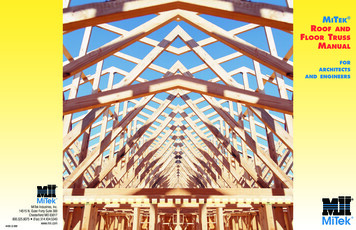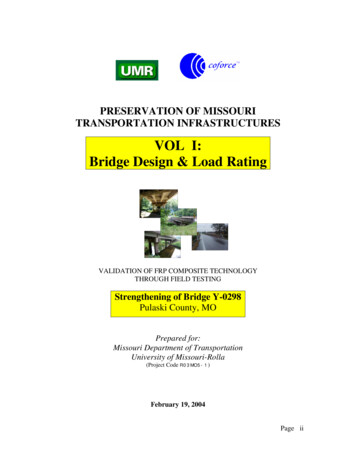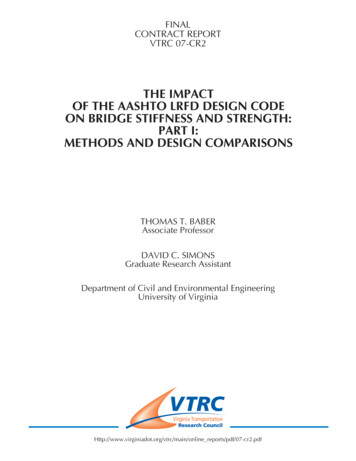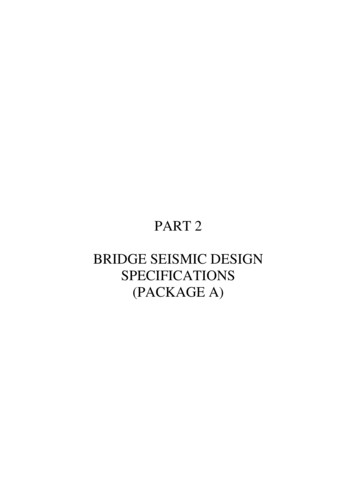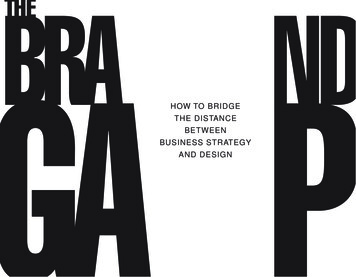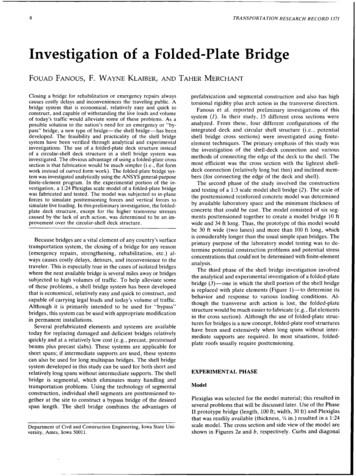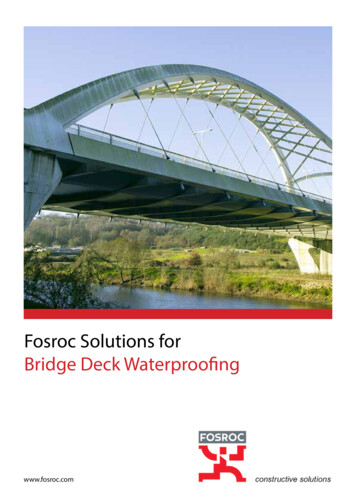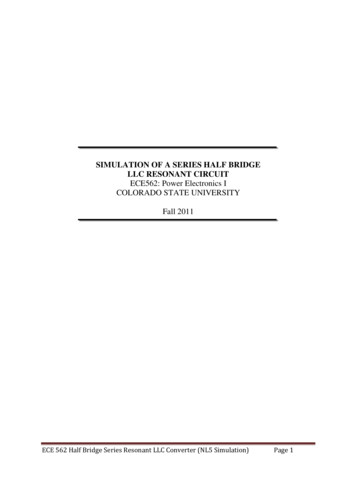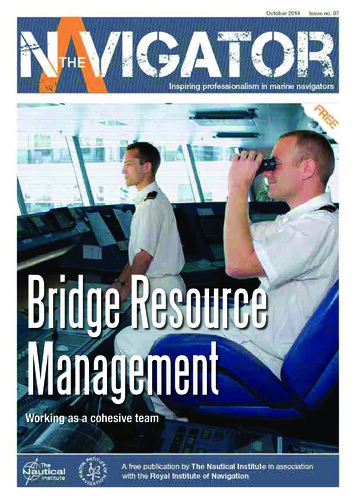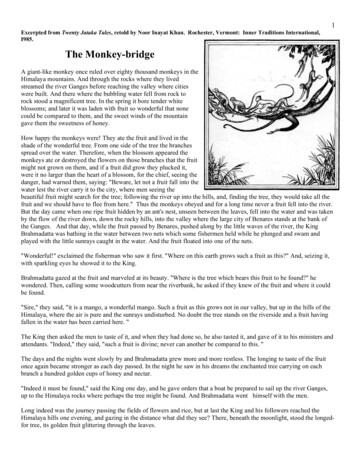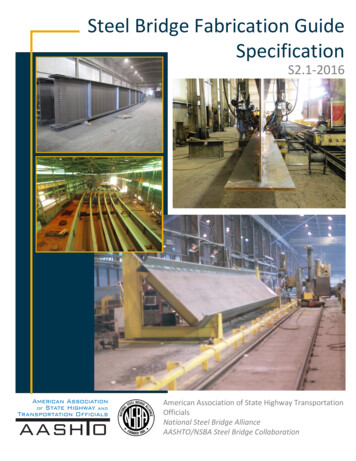
Transcription
EDSGN100 Truss Bridge DesignFinal Design ReportIntroduction to Engineering DesignEDGSN 100; Section 001Fantastic Four(Design Team #3)Cassandra E. Baum, www.personal.psu.edu/ceb5446, ceb5446@psu.eduJoshua A. Moser, www.personal.psu.edu/jwm5888, jwm5888@psu.eduSherylee Harley, www.personal.psu.edu/svh5337@psu.edu, svh5337@psu.eduAdarsh Vasudevan, www.personal.psu.edu/ayv5110@psu.edu, ayv5110@psu.eduSubmitted to: Prof. BerezniakDate: 04/08/20131Spring 2013
EDSGN100 Truss Bridge DesignFinal Design ReportTable of ContentsExecutive Summary 012.0Introduction . . .General Factors for Design .Structural Constraints. . . . . Construction Constraints. . .Quality Control Testing. . . .Aesthetics . . .Economics . . . . .Consideration of Design Alternatives Selection of Bridge Design . . .Prototype Construction . . .Estimated Load Capacity . . .Prototype Load Testing . . .Prototype Performance and Forensic Analysis . . .Final Design Performance . .Refine the Design. . Conclusions and Recommendations . . References. . . .Table 1Table 2Table 3Table 4Table 5Table 6Table 7List of TablesDry Stick Weight Wet Stick Weight . . .Dry Glued Stick Weight. . . .Material Costs .Force Chart 1 .Force Chart 2 .Overall Ranks .Page 4Page 5Page 5Page 5Page 5Page 6-8Page 8Page 8Page 8-9Page 9-10Page 11Page 11Page 11Page 12Page 13Page 13-14Page 14Page 14-15Page 6Page 6Page 7Page 8Page 9Page 10Page 13Figure 1Figure 2Figure 3Figure 4List of FiguresQuadrangular Through Warren Truss . Customized Camel Back Truss Bridge .Side View . Failure Points Page 9Page 10Page 11Page 12, 14Chart 1Chart 2List of ChartsWeight of Popsicle Sticks w/o Glue Weight of Popsicle Sticks w/ Wet Glue Page 6Page 72Spring 2013
Chart 3Weight of Popsicle Sticks w/ Dry Glue 3Page 8Spring 2013
EDSGN100 Truss Bridge DesignFinal Design ReportExecutive SummaryWe were approached by a company to design a bridge that was strong, aesthetically pleasing,and economically efficient. We were to come up with a prototype using wood craft sticks andwhite Elmer’s glue. We were given specific specifications that we needed to follow, or else orcompany would not be pleased with our efforts and we would not get paid with a good grade.Through some analysis, we tested to see how many craft sticks we could use without going overthe maximum weight. We then made our bids based off of this estimate. We bought a lot ofmaterials for a simple bridge design. Our design was simple because we were trying to make it arealistic task where we would not be given all the material and money that we wanted. For ourpurchasing of materials, we went with the better safe than sorry approach; however we did notuse a lot of our materials. We came up with a customized Camel Back Truss Bridge design, tomake it a very realistic type of bridge that could be used. Once we constructed our bridge, wetested it by adding weight to a bucket that was suspended from the deck of our bridge, ten inchesfrom the one side. The quality of which we built our prototype was great. We definitely took ourtime to make sure that we put everything together in the correct way. Our bridge performed in anaverage matter, where we held 47.6 pounds, which was good for the amount of material we used.Our bridge failed on the deck as well as our one end post. Our bridge could have been improvedthrough the use of more lateral bracing and struts towards the ends of our bridge. We alsodecided that the next time we would improve our design by adding structural support underneaththe deck, because we had no support there. Overall our bridge did extremely well with ourrankings in the class. We were tied for second best overall bridge design, and we feel that wecould make this ranking even better through the implementation of everything that we have4Spring 2013
learned in this engineering design process. We are now more prepared and ready for the nexttask than when we were before we started this project.1.0. Introduction.Design project 1 was to build a truss bridge using popsicle sticks and Elmer’s glue. Whilebuilding the bridge we were to make the strongest prototype we could, but also minimize costand weight and also make it aesthetically pleasing. Upon building the bridge we were givencertain constraints including weight and dimensions. Before beginning construction we didtesting to see how much glue was required to glue two popsicle sticks together with the moststrength. Also in our concept design we had to consider the ease of construction, aesthetics,strength, and weight. After construction we will load test it to failure then analyze why it failed.2.0 General Factors for Design.2.1 Structural Constraints.Our bridge was to be 30-34 inches in length, while not exceeding 400g. It could notbe taller than 10 inches and below the deck could not exceed 3 inches. The width had to be nomore than 5 inches. Overall the bridge would have to accommodate a 4 by 4 inch vehicle. Thereare no I-beams or box-beams allowed. Popsicle sticks are not allowed to overlap over 50% ofanother stick. Our prototype was a customized Camelback Truss Bridge because we felt thesimple design would work best as a realistic situation and our customized touch would increasethe aesthetics a little.2.2 Construction Constraints.We were limited to only 2 types of materials, including wood craft sticks and whiteElmer’s glue. Connections of the sticks could only contain 6 sticks maximum. There must be atleast a 1-inch clear gap between any two stacks. The deck of the bridge had to be completelycontinuous along its width and length, while containing a gap at 10 inches from one end to allowthe load to be attached during the testing process. For load testing, the bridge will set on supportsthat will be provided by the Instructor. No special supports may be used. The end supports willhave the dimensions of: 3/4-inches wide x 3/4-inches high x 5-inches long. The end supports willbe placed 29-inches apart (center-to-center).5Spring 2013
2.3 Quality Control Testing.Table 1Dry Popsicle Stick Weight#Sticks2468101214161820dry Weight Chart 1Table #2Wet glued Popsicle sticks Weight#Sticks wet glue Weight 1216 1.3333331418.7 1.3357141621.5 1.343756Spring 2013
182024.5 1.36111127.11.355Chart #2Table #3Dry Glued Popsicle Sticks Weight#Sticks dry glue weights 318751.3333331.325Spring 2013
Chart #3As seen by our graphs and tables, we used data collected, essentially, by the entire class toconstruct equations to see how much of each type of material we could use, while still stayingunder the 400g limit. We weighed the sticks in groups of twos to make a rough graph of how thesticks, wet sticks, and dry stick’s weights increased with more sticks.2.4 Aesthetics.Our bridge design is a hybrid of a Camelback and K-Truss design, we thought that the curvaturegave the design a better appeal to people and overall created a more aesthetic bridge. With avery basic and common bridge appearance, we felt the aesthetics would be familiar to acommon person.2.5 Economics.We had to pay for the wood craft sticks individually and the glue per gram. In the first round ofbuying, the sticks cost 1000 and the glue cost 5000 per gram. As seen in the table, we bought315 sticks and 50 grams of glue. We definitely spent too much during this time because we didnot use all of our materials. I guess it’s better safe than sorry though. We bought extras toaccount for the possibility of getting a number of faulty sticks. We did not need to buy extramaterials.Table 43.0 Consideration of Design Alternatives.We considered this simple quadrangular bridge design because we felt it was one of themost basic types of bridges out there. People often overlook the simple things in life. Butif it is simple and very common, scientists and engineers must be a reason for it. This iswhy we considered it.8Spring 2013
Table 5Quadrangular Through Warren TrussFigure 14.0 Selection of Bridge Design.We decided to go with our customized bridge design because we felt that it was moreaesthetically pleasing and it kept our simple mindset. We wanted to keep this mindset.While it was customized slightly by our group, we felt that we did not do anything toodrastic to inhibit its original function to provide safe passage across a valley. We felt that9Spring 2013
the weight, strength, and cost would be very similar for both bridges. Ease ofconstruction and aesthetics were why we picked this bridge type.Table 6Customized Camel Back Truss BridgeFigure 210Spring 2013
5.0 Prototype Construction.We worked on the construction of this bridge for 3 full class periods and one session outsideof class, adding up to about 22 man hours total. We did not get a measure of our total bridgeweight because our entire class skipped this step. We were too excited to actually test ourbridges. As team 3, we used 17.3 grams of glue, which was way less than what we purchased.We could have saved a lot of money. But in the real world, we would be able to use that materialfor our next project, whatever that may be.Figure 36.0 Estimated Load Capacity.Our estimated load capacity of our bridge was 55 pounds and we came up with this estimateby examining the compactness of our design, while being extremely realistic.7.0 Prototype Load Testing.The bridge will be loaded on the roadway (deck or road surface) 10-inches from one of the ends.The loaded end will be determined by the Instructor on bridge loading day.The load will be applied on a 3-inch square loading plate with the center of the plate placedexactly 10-inches from one end of the bridge on the roadway (deck). A 3x3-inch square will bedrawn on your bridge at the contest. The load will be applied from weight applied below theroadway. The bridge must be constructed to allow a steel cable or chain to be suspendedvertically from the 3-inch square loading plate and hang below the deck. The bridge will becontinually loaded until catastrophic failure, meaning the bridge could no longer function as safe,useable bridge. After loading and bridge failure, each design team must perform a detailed11Spring 2013
orensic engineering investigation to determine the cause of bridge failure. The investigation shallbe documented with notes, sketches, drawings, and photographs.8.0 Prototype Performance and Forensic Analysis.Once our testing was finished, we discovered that our bridge withstood 47.6 pounds. For theamount of material that we used, our bridge performed pretty well. We were unable to determineFailure Load to Bridge Weight Ratio because, as a class, we forgot to measure the total weight ofour bridges. The bridge failed at the end of the deck and at the one corner as shown in the figure.This part of the bridge is called the end post. A large portion or our deck also fell out. I think thismay be because we had no lateral bracing or struts towards the end of the bridge. The rest of thebridge held strong and sturdy. Only minor repairs would have to be made.Figure 412Spring 2013
9.0 Final Design Performance.Table 7Our overall rank compared to the other teams is very impressive. We managed to tie for secondout of the 8 teams. Our BELC helped us a lot in this, as our guess was very close at 13.5%. Ourbiggest weakness was the load rank, which could easily be weighted to be the most importantrank. However, our load was 47.6 pounds which came in as the sixth best in the class. I believethat our aesthetics, being that our bridge was a very common bridge type, worked in ouradvantage because while it was not too fancy, the voters were familiar with the design andranked our bridge as fourth best. Our cost rank also helped us out a great deal as we were rankedthird. This could have been even better, but I think we are still proud of it.10.0 Refine the Design.If our bridge was redesigned, we would definitely make changes so that there would be morestructural support underneath the deck, taking advantage of the 3 inches that we could have hadthere. In our actual bridge design, we did not have any form of structure underneath the deck. Ithink we would also use more struts and lateral bracing towards the ends of the bridge because13Spring 2013
that may have helped with the failure of the one corner of our bridge, as shown in the picture.Figure 4Failure Points11.0 Conclusions and Recommendations.Throughout this project and assignment, we were able to come up with an average bridgedesign that uses minimal materials and will be economically efficient. We definitely learnedabout estimating needed materials, as we did not do this well at all. We also learned and believethat lateral bracing could have done wonders for our bridge design. We could also add structuralsupport underneath our deck of our bridge, as we had none. This would have greatly improvedour decks condition and given us a lot more load capacity.12.0 References.12.1 ANGEL/Lessons/Design Project #1/EDSGN100 BridgeBuilding SOW Sp2013.doc.12.2 ANGEL/Lessons/Design Project #1/Final Design Report/EDSGN100 BridgeBuilding Specifications Sp2013.doc.12.3 ANGEL/Lessons/Design Project #1/Final Design Report/EDSGN100 StickWeights Sp2013.xlsx.12.4 ANGEL/Lessons/Design Project #1/Final
Design project 1 was to build a truss bridge using popsicle sticks and Elmer’s glue. While building the bridge we were to make the strongest prototype we could, but also minimize cost and weight and also make it aesthetically pleasing. Upon building the bridge we were given certain constraints including weight and dimensions. Before beginning construction we didFile Size: 613KBPage Count: 15
